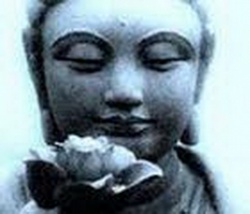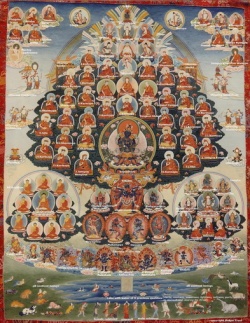A few modern philosophical terms
During his years of explaining Buddhist philosophy and practice in the West, Shamar Rinpoche has invented many colorful terms to drive the point home. Here are a few of the idioms he has used in recent teachings:
Pushy crowdy karma is a loose translation of the Tibetan term lenpé namshé (len pa’i rnam shes), the perpetuating consciousness that leads to a certain kind of rebirth as it identifies with a particular physical form and the modes of perception specific to it. When factors and conditions cause karmic seeds to sprout and ripen, this pushes individual consciousness to assume a new form and identify with it. An example of this is the great Indian king Ashoka who, despite having garnered enormous merit through spreading the Dharma, died in a moment of anger. Of all the karmic seeds he had sown during his lifetime as an emperor, the seed of anger was the most immediate and pushy; it ripened first and Ashoka was reborn as a python for a short while.
Mahasiddhas such as Tilopa are able to recognize which mantric mind corresponds with a student’s karmic predisposition. By introducing the student to the meditation deity, or yidam, practice that is most likely to serve as an antidote to confusion and lead to awakening, the master guides the student’s mantric mind to reconnect with its fundamental nature.
Because there are countless sentient beings with as many karmic predispositions, Buddha Shakyamuni taught innumerable tantras in lands such as Oddiyana to the students that would best benefit from such practices. The reason tantric practices of this kind are so secret is to protect students from phony ‘masters’ who might invent fake tantras for dishonorable reasons such as personal fame or wealth. Ill-chosen or bogus yidam practices can potentially cause a great deal of harm or, at the very least, hinder a student’s progression along the path to awakening, because the practitioner’s mantric mind and the tantra don’t match.
Among the twelve interdependent links, the fourth is often translated as ‘name and form’. Although this is a literal translation of the Sanskrit and Tibetan terms (Skt: nama-rupa; Tib: ming dang gzugs), Shamar Rinpoche favors the term labeling form, as it refers to the mind which grasps a physical form and its constituents as being “me’ or ‘I,’ and anything perceived as belonging to it as being ‘my’ and ‘mine.’ Once an individual consciousness has appropriated a new form and other aggregates, it identifies with them in terms of a self: I am a person, I am a dog, I am a fish, and so on. This identification is what is meant by labeling form.
These first three are related and work together. Rinpoché has also used the term package believer to describe Western practitioners whose understanding of the Dharma is limited because they lump everything together and tend to be rather inflexible.
Another major problem is that Westerners are machine-minded in that they are inclined to believe that everything exists, including the mind which meditates. Their understanding is often quite technical and intellectual. Even in meditation, the concept of subject and object is present and thinking is considered a sort of wiring process which arises out of mind: three wires come together and thought occurs. The thinker is a button; press the button and a thought arises. In truth, however, this machine-minded point of view is terribly reductionistic because mind’s nature is perfectly vast and unlimited.
Source
by Shamar Rinpoche
as told to Pamela Gayle White
www.bodhipath.org

